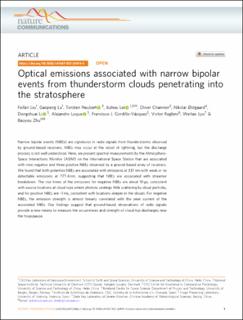| dc.contributor.author | Liu, Feifan | |
| dc.contributor.author | Lu, Gaopeng | |
| dc.contributor.author | Neubert, Torsten | |
| dc.contributor.author | Lei, Jiuhou | |
| dc.contributor.author | Chanrion, Olivier | |
| dc.contributor.author | Østgaard, Nikolai | |
| dc.contributor.author | Li, Dongshuai | |
| dc.contributor.author | Luque, Alejandro | |
| dc.contributor.author | Gordillo-Vázquez, Francisco J. | |
| dc.contributor.author | Reglero, Victor | |
| dc.contributor.author | Lyu, Weitao | |
| dc.contributor.author | Zhu, Baoyou | |
| dc.date.accessioned | 2022-04-06T08:41:00Z | |
| dc.date.available | 2022-04-06T08:41:00Z | |
| dc.date.created | 2021-12-02T08:47:39Z | |
| dc.date.issued | 2021 | |
| dc.identifier.issn | 2041-1723 | |
| dc.identifier.uri | https://hdl.handle.net/11250/2990102 | |
| dc.description.abstract | Narrow bipolar events (NBEs) are signatures in radio signals from thunderstorms observed by ground-based receivers. NBEs may occur at the onset of lightning, but the discharge process is not well understood. Here, we present spectral measurements by the Atmosphere‐Space Interactions Monitor (ASIM) on the International Space Station that are associated with nine negative and three positive NBEs observed by a ground‐based array of receivers. We found that both polarities NBEs are associated with emissions at 337 nm with weak or no detectable emissions at 777.4 nm, suggesting that NBEs are associated with streamer breakdown. The rise times of the emissions for negative NBEs are about 10 μs, consistent with source locations at cloud tops where photons undergo little scattering by cloud particles, and for positive NBEs are ~1 ms, consistent with locations deeper in the clouds. For negative NBEs, the emission strength is almost linearly correlated with the peak current of the associated NBEs. Our findings suggest that ground-based observations of radio signals provide a new means to measure the occurrences and strength of cloud-top discharges near the tropopause. | en_US |
| dc.language.iso | eng | en_US |
| dc.publisher | Nature | en_US |
| dc.rights | Navngivelse 4.0 Internasjonal | * |
| dc.rights.uri | http://creativecommons.org/licenses/by/4.0/deed.no | * |
| dc.title | Optical emissions associated with narrow bipolar events from thunderstorm clouds penetrating into the stratosphere | en_US |
| dc.type | Journal article | en_US |
| dc.type | Peer reviewed | en_US |
| dc.description.version | publishedVersion | en_US |
| dc.rights.holder | Copyright 2021 The Author(s) | en_US |
| dc.source.articlenumber | 6631 | en_US |
| cristin.ispublished | true | |
| cristin.fulltext | original | |
| cristin.qualitycode | 2 | |
| dc.identifier.doi | 10.1038/s41467-021-26914-4 | |
| dc.identifier.cristin | 1963104 | |
| dc.source.journal | Nature Communications | en_US |
| dc.identifier.citation | Nature Communications. 2021, 12, 6631. | en_US |
| dc.source.volume | 12 | en_US |

